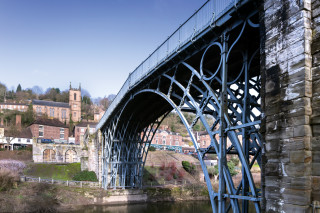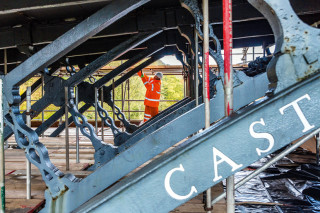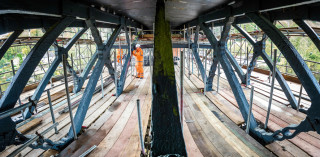Few structures can claim to have been quite as influential to modern engineering as the Iron Bridge in Shropshire. Erected in 1779 by ironmaster Abraham Darby III, the bridge spans 30m over the River Severn, and was the first single-span arch bridge in the world to be made of cast iron. It marked a turning point in British engineering: after the bridge was built, cast iron came to be widely used in the construction of bridges, aqueducts and buildings, and the structure is seen as the precursor to today’s railways and skyscrapers.
Not surprisingly, the Iron Bridge has undergone various repairs over its almost 240-year history, but it is remarkably intact, with the vast majority of its elements still being the original castings. The latest repairs are just coming to an end, having been under way since autumn 2017. English Heritage, which is responsible for looking after the Iron Bridge, claims it is the most comprehensive repair and conservation project carried out on the structure to date.
The £3.6m project follows extensive surveys and investigations, which showed that the bridge is under threat from cracking. This is due to a range of factors, including stresses in the ironwork dating from the original construction, ground movement over the centuries, and an earthquake that hit the region at the end of the 19th century.
Almost as soon as the bridge was completed, ground movement in the gorge meant that the abutments were being pushed together. Records show that as long ago as 1801 the bridge’s trustees investigated a scheme to hold the abutments apart with an underwater timber strut. The scheme was rejected, but was revived over 150 years later, when, in the late 1960s, it was thought that the bridge was close to collapse as the banks were being pushed ever closer to each other.
The solution was to hold the abutments apart by building a reinforced concrete strut 4.5m below the water level. According to Ed Morton, managing director of the Morton Partnership, lead consultant for the current repair project, prior to this intervention the abutments had moved in by around 600mm, causing the bridge to become compressed and to crack in places.
“The bridge has been monitored, and there is no evidence of any more movement after the below-water strut was put in,” he explains. “But, while movement from the gorge isn’t an issue, ongoing corrosion of some of the iron is an issue.”
Before the Morton Partnership got involved, consultant Ramboll carried out research into all the work that had been done on the bridge in the past, and created a finite element model to enable a comprehensive analysis of the structure and how it works. English Heritage then used Ramboll’s report to develop the strategy for the current conservation project.
In essence, that strategy involves all the different elements of the bridge – the iron radials and braces, the deck plates and wedges, the main iron arch and the stone abutments on either side of the river – being examined, repaired and occasionally replaced, though only where absolutely necessary.
It is unusual, even among conservation projects, that the emphasis here is not on strengthening the structure, but on keeping it intact in its original form. “We haven’t had to strengthen the structure,” says Morton. “The Iron Bridge was in vehicular use for a long time, so there is quite a high degree of redundancy, which means there is no problem with its load-bearing capability.
“What we’re doing now is a case of really trying to make sure that, where elements are damaged or have failed, they won’t fall off in the future, and we can retain them for as long as possible.”
The lead contractor for the project is Taziker Industrial, a specialist in historic bridges and similar structures. Technical and estimating engineering director Matt Greenhalgh says: “As an engineer, I just want to fix everything, but as a conservation project you have a completely different train of thought. The whole idea is to conserve the structure in its original form as much as is humanly possible.
“If you see something broken, you want to fix it,” he adds, “but on a conservation project like this, you may have an element that has a fracture, but from a structural point of view it is it still working. In that case it’s a question of whether we can rely on it staying there, or if we have to hold it with a clamp. It’s not necessarily about fixing everything that’s broken.”
The Morton Partnership carried out the detailed design of the works set out in the Ramboll report, and also produced the tender documents and specification – although that wasn’t easy on a structure where many of the elements are hidden from view.
“One of the main difficulties was that until we had the scaffolding up, we had limited access to the actual bridge,” says Morton. “We had done road deck surface surveys, and we knew there were areas of ironwork that we needed to do something about, so we developed a whole menu of repair options that could be carried out to specific areas.
“We produced the tender documents, and a quantity surveyor was involved in putting together a schedule of works that was quantified as best as possible,” he adds.
Taziker Industrial won the contract with a tender that included bringing in specialist conservation metalwork contractors for some of the tasks. “The contract consisted of grit blasting and painting of the ironwork, ironwork repairs, masonry repairs, removal of the surface of the bridge and installing a new waterproof lining and resurfacing of the deck,” explains Greenhalgh. “Because of the size of the project, we knew we could only do one aspect of the work and would need to bring in other specialists.
“Blasting and painting is our core work – we do that all time,” he adds. “But when it came to the ironwork repairs, we took a three-pronged approach: either in-house; or where replacement castings were needed, we used a local foundry, Barr & Grosvenor; and for the things they couldn’t do we went to Topp & Co because of their wealth of knowledge and experience working on cast iron structures.”
Greenhalgh says that when he was looking through historical documents relating to previous repairs on the Iron Bridge, he saw Barr & Grosvenor director Dominic Grosvenor’s name come up. “I noticed his experience and chatted to him and made sure they were involved in the tender,” says Greenhalgh. “But they could only do certain types of work, which is why we also involved Topp & Co.
“I think English Heritage realised we had concentrated on making sure the areas we physically did ourselves were suitable for our existing skill set, and that we had brought in experts where we needed them,” he adds. “There are very few people who have that experience in the industry.”

The contractor’s first challenge was to erect the access scaffolding from which everyone would be working. “We have our own company for the supply and installation of access scaffolding, but this was a unique situation because – unlike most structures – we couldn’t hang any scaffolding off the structure,” explains Greehalgh. “It had to be free-standing, with all the loading from the scaffolding ending up on either side of the river at the bottom level.”
The access scaffolding was built using 30m-long aluminium beams spanning between the two river banks. These had to be lifted into place using a large mobile crane sitting on the road in Ironbridge village.
Once the temporary structure was in place, Taziker Industrial was able to start grit-blasting the ironwork to remove the old paint and rust, exposing the iron itself and any defects that needed repairing. “As we carried out the blasting works to remove all the layers of paint, that has led to us finding out other issues,” explains Greenhalgh.
This process of discovery enabled the contractors and the designer to identify which of the menu of repair options were appropriate for every location. “Most of what we did was holding repairs – stopping any of the original fabric dropping off,” says Greenhalgh. “But there were also some situations where replacements had to be fabricated, either because an element was missing completely or it was damaged beyond repair.”
These new elements had to match the original pieces exactly, which is not easy when the bridge was constructed using individually cast pieces of metal. “A lot of the pieces look identical to the piece next to them, but only some smaller pieces were cast using a pattern. The rest – including the big sweeping arches – were all individually made,” explains Greenhalgh.
“Pieces might look identical, but there will be discrepancies, so every time we did repairs they had to be individually templated.”
As Greenhalgh says, much of the work consisted of “clamping repairs”, designed to clamp two fractured sections together. These were done by manufacturing clamping plates either in galvanised mild steel or galvanised pure iron, and then bolting these plates to each other either side of the existing damaged section of cast iron.
“The plates were templated, and a sample set manufactured in plywood first to enable these to be physically tried in situ, to establish if the correct profile and fit had been achieved,” explains Greenhalgh. “After these had been trialled, the permanent repair plates would be made to these templates.”
One of the highest-value repair jobs was on the deck, where there are over 250 wedges that drop into holes in the deck plates to locate the plates on top of the support beams. Many of these had corroded away and had to be replaced, and here Barr & Grosvenor had to make individual plywood templates for each wedge before making new ones in cast iron. As Greenhalgh says: “It was quite an intensive job.”
When the Iron Bridge was built in the 18th century, the larger items were cast right next to the bridge construction site in the local village using an open casting process. This involved sand being used to form the mould for the structural element, with the shape of the piece carved out in the sand, and then the molten iron poured into the indentation. As a result, all the pieces cast in this way have one face that is open; and as the iron cools, gas bubbles rise to this surface, leaving it with blemishes and prone to porosity.
“It’s not particularly detrimental but it can be quite unsightly, so they just made sure all these faces pointed inwards,” explains Greenhalgh. “When we blasted, we exposed all these little holes, but because it is an ancient monument we were not allowed to fill them or seal them.
“You might get some weeping of rust from the structure because of all these porosities, but it is not detrimental to the structure,” he adds.
While the access scaffolding was in place, English Heritage took the opportunity to look for samples of the original paintwork. Detailed analysis of those samples revealed that the Iron Bridge was originally painted in a very dark red-brown lead-based oil paint – not the blue-grey colour visitors have become used to. As part of the current conservation project, Taziker Industrial has returned the structure to this original colour scheme, which can be seen in a famous painting of the site, Cast Iron Bridge near Coalbrookdale, painted in 1780 by William Williams.
English Heritage senior property curator Dr Heather Sebire says: “Uncovering the original colour of the Iron Bridge has been a fascinating mix of both archive research work and detailed forensic investigation. We had already found some clues in the archives but the decider was the results of our analysis of the historic paint, revealing a red-brown coating beneath centuries of historic dust and paintwork. That’s when we knew we had found the answer to the key question about the original colour of the Iron Bridge.”
Interest in the colour scheme is just one illustration of the conservation project’s high profile. Throughout the summer a public walkway was open alongside the Iron Bridge to enable visitors to watch the contractors as they worked on the repairs and repainting.
With the work now almost complete, the structure is starting to be unwrapped, and visitors will soon be able to see the entire bridge looking much as it did on the day it first opened.

This article was first published in the December/January 2019 issue of The Construction Index magazine
UK readers can have their own copy of the magazine, in real paper, posted through their letterbox each month by taking out an annual subscription for just £50 a year. Click for details.
Got a story? Email news@theconstructionindex.co.uk




